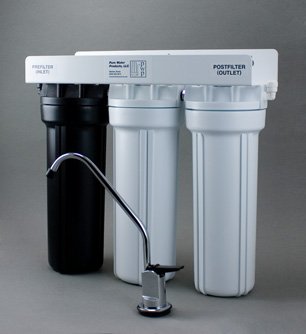Undersink Water Filters: Better than they used to be.
By Pure Water Annie
Gazette Technical Consultant Pure Water Annie explains how undersink water filters have improved in recent years.
An undersink water filter is a treatment device that is inststalled under the kitchen sink but dispenses its treated water on the sink top. This is a very practical and efficient arrangement because it leaves the countertop uncluttered but allows plenty of equipment space for excellent filtration.
Several improvements in recent years have made undersink filters extremely effective, practical, and easy to install and service. These include
- The replacement of copper and galvanized undersink piping with flexible connectors.
- The improvement in filter housing and cartridge designs that allows installation of more compact and easy-to-service filtration units.
- The improvement in filtration technology that allows targeted treatment of many more problem contaminants.
The use of flexible undersink pipes not only makes installation of standard undersink filters with their own dispensiing faucet much easier and safer, it also allows very easy installation of “simple” undersink filters, the type that dispense water through the existing cold water side of the sink faucet rather than an added ledge faucet. (For the difference between “simple” and standard undersink filters, see How Undersink Filters Work.)
Modern filter housings are now available that make cartridge changes as easy as changing a light bulb. Even traditional housings have been improved so that the best brands are easy to open and virtually leak-proof.
Carbon block filters have been steadily improved over the years so that now extra fine powdered carbon provides much more effective filtration and greatly increased cartridge life as compared with old granular carbon filters. In addition, cartridges can now be made to target specific contaminants like lead, arsenic, fluoride, iron, bacteria, nitrates, low pH, and cysts.
This last aspect, the use of “media cartridges” for special purposes, is especially effective with multi-filter undersink units that use two or more canisters with different cartridges.
The classy triple undersink filter shown above has exceptional chlorine/chloramine reduction capacity and can, depending on the cartridges chosen, remove such contaminants as bacteria, cysts, nitrates, colors, sediment, odors, lead, iron, arsenic, fluoride, and more. Go here for a listing of cartridges that will fit this filter.




![pwanniemedium[1]](http://www.purewatergazette.net/blog/wp-content/uploads/2012/05/pwanniemedium1-246x300.jpg)

